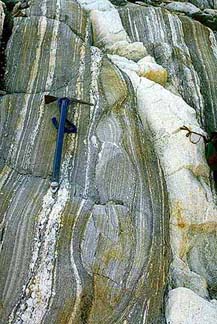Rock (geology)

In geology, rock or stone is a naturally occurring solid aggregate of minerals and/or mineraloids.
The Earth's outer solid layer, the lithosphere, is made of rock. In general rocks are of three types, namely, igneous, sedimentary, and metamorphic. The scientific study of rocks is called petrology, and petrology is an essential component of geology.
Contents |
Rock classification

Rocks are generally classified by mineral and chemical composition, by the texture of the constituent particles and by the processes that formed them. These indicators separate rocks into igneous, sedimentary, and metamorphic. They are further classified according to particle size. The transformation of one rock type to another is described by the geological model called the rock cycle.

Igneous rocks are formed when molten magma cools and are divided into two main categories: plutonic rock and volcanic. Plutonic or intrusive rocks result when magma cools and crystallizes slowly within the Earth's crust (example granite), while volcanic or extrusive rocks result from magma reaching the surface either as lava or fragmental ejecta (examples pumice and basalt) .[1]

Sedimentary rocks are formed by deposition of either clastic sediments, organic matter, or chemical precipitates (evaporites), followed by compaction of the particulate matter and cementation during diagenesis. Sedimentary rocks form at or near the Earth's surface. Mud rocks comprise 65% (mudstone, shale and siltstone); sandstones 20 to 25% and carbonate rocks 10 to 15% (limestone and dolostone).[1]

Metamorphic rocks are formed by subjecting any rock type (including previously formed metamorphic rock) to different temperature and pressure conditions than those in which the original rock was formed. These temperatures and pressures are always higher than those at the Earth's surface and must be sufficiently high so as to change the original minerals into other mineral types or else into other forms of the same minerals (e.g. by recrystallisation).[1]
The three classes of rocks — the igneous, the sedimentary and the metamorphic — are subdivided into many groups. There are, however, no hard and fast boundaries between allied rocks. By increase or decrease in the proportions of their constituent minerals they pass by every gradation into one another, the distinctive structures also of one kind of rock may often be traced gradually merging into those of another. Hence the definitions adopted in establishing rock nomenclature merely correspond to selected points (more or less arbitrary) in a continuously graduated series.[2]
Human use
The use of rocks has had a huge impact on the cultural and technological development of the human race. Rocks have been used by humans and other hominids for more than 2 million years. Lithic technology marks some of the oldest and continuously used technologies. The mining of rocks for their metal ore content has been one of the most important factors of human advancement, which has progressed at different rates in different places in part because of the kind of metals available from the rocks of a region.
The prehistory and history of civilization is classified into the Stone Age, Bronze Age, and Iron Age. Although the stone age has ended virtually everywhere, rocks continue to be used to construct buildings and infrastructure. When so used, rocks are called dimension stone.
See also
- Dimension stone
- Geologic time scale
- Geomorphology
- Kekur
- List of rock types
- Oldest rock
- Quarry
- Rauk
- Riprap
References
- ↑ 1.0 1.1 1.2 Blatt, Harvey and Robert J. Tracy, 1996, Petrology, W. H. Freeman, 2nd ed. ISBN 0-7167-2438-3
- ↑
 This article incorporates text from a publication now in the public domain: Chisholm, Hugh, ed (1911). "Petrology". Encyclopædia Britannica (Eleventh ed.). Cambridge University Press.
This article incorporates text from a publication now in the public domain: Chisholm, Hugh, ed (1911). "Petrology". Encyclopædia Britannica (Eleventh ed.). Cambridge University Press.